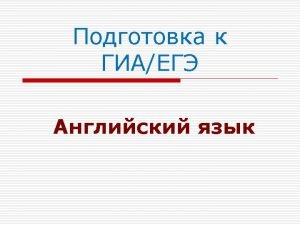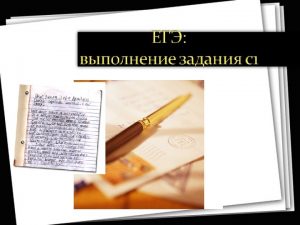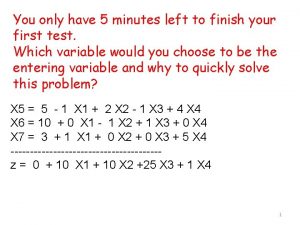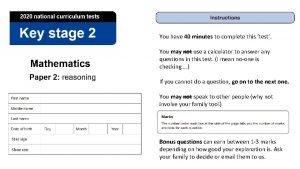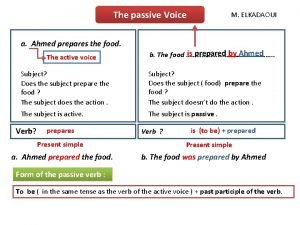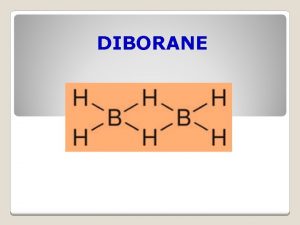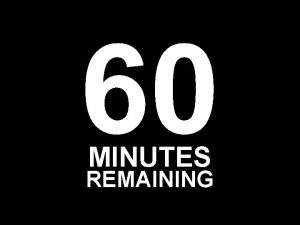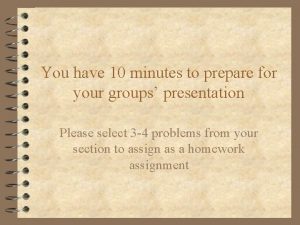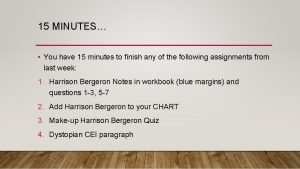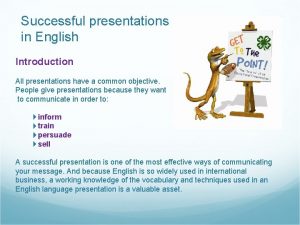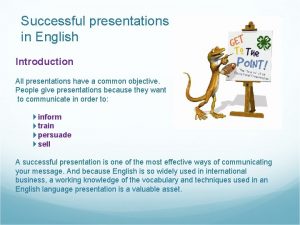Prepare for Presentations You will have 10 minutes













- Slides: 13

Prepare for Presentations � You will have 10 minutes to meet with your group to prepare for presentations. � You have a maximum of 5 minutes to present your poster.

Presentation Components � Explain the design of your helmet. ◦ How did it protect/not protect the egg. ◦ What design features did you specifically use to protect the egg. ◦ How does your helmet absorb/not absorb the energy from impact? � Explain how your design changed. � What regions of the brain were injured and what corresponding functions would be impacted from the TBI? � What changes would you make?

Presentation Rubric CATEGORY 4 3 Student seems pretty prepared but might have needed a couple more rehearsals. 2 The student is somewhat prepared, but it is clear that rehearsal was lacking. 1 Preparedness Student is completely prepared and has obviously rehearsed. Speaks Clearly Speaks clearly and distinctly most ( 94 -85%) of the time. all (100 -95%) the time, and all (100 -95%) the time, but Mispronounces no more than mispronounces no words. mispronounces one word. Often mumbles or can not be understood OR mispronounces more than one word. Content Shows a full understanding of the topic. All topics and questions addressed on the poster. Shows a good understanding of the topic. All but 1 topic or question is addressed on the poster. Shows a good understanding of parts of the topic. All but 2 topics or questions addressed on the poster. Does not seem to understand the topic very well. More than 2 questions or topics are missing from the poster. Visual Appeal Poster is neat and easy to read. No spelling or grammatical errors. Poster is neat and easy to read. 1 -2 spelling or grammatical errors. Poster is disorganized. 3 -5 spelling or grammatical errors. Poster is hard to read and very disorganized. More than 5 spelling or grammatical errors. Volume is loud enough to be heard by all audience members throughout the presentation. Volume is loud enough to be heard by all audience members at least 90% of the time. Volume is loud enough to be Volume often too soft to be heard by all audience members at least 80% of the members. time. Student does not seem at all prepared to present. Total

Hanging up the posters… � We are going to hang them on the wall outside my door.

Brain Quiz Basic Information: Regions of the Brain � ◦ ◦ ◦ NOT open notes. � Thursday (Juniors) Monday (Seniors) � TBI • • • Know the difference between closed & open TBI Be familiar with problems that can arise from a TBI • This is from a specific slide of my notes: there are examples of cognitive & behavioral. Be able to explain how helmets protect against TBI in terms of energy absorption. Be able to label the brain’s regions � Cerebrum Brain Stem Cerebellum Spinal Cord Limbic System Know key functions of each region (except spinal cord). ◦ Be able to explain brain function during a basic activity.

Muscle Tears Injuries: Part 2

Facts about muscles � 600 muscles in the human body � There are 3 types of muscle: ◦ Smooth ◦ Skeletal ◦ Cardiac

Smooth Muscle � Spindle-shaped cells containing a single nucleus. � Muscles of the: ◦ Stomach, intestines, arteries, veins, & other internal organs. � Can remain contracted for long periods of time. � Contracts slowly & smoothly. � Involuntary.

Skeletal Muscle � Usually found attached to skeleton. � Long, straight with multiple nuclei � Has bands, or striations. � Voluntary control � Connects to tendons & bones to provide movement

Cardiac Muscle � Produces the force needed to pump the heart. � Has striations or banding like skeletal muscle � Under involuntary control (like smooth muscle)

Venn Diagram � Synthesize your notes into a Venn Diagram. � Be sure to include all information we covered in our notes. � These will be turned in. � You will be given a half-sheet of paper.

Cardiac Smooth Skeletal

Remainder of Class � Study for your quiz.
 1 minute=60s
1 minute=60s What language
What language You have 30 minutes to do this task
You have 30 minutes to do this task You have 20 minutes to do this task
You have 20 minutes to do this task You have 20 minutes to do this task
You have 20 minutes to do this task 5 minutes left
5 minutes left You will have 40 minutes to complete the test.
You will have 40 minutes to complete the test. I have not rejected you
I have not rejected you Yourexec
Yourexec Youexec
Youexec It has six faces 12 edges and 8 vertices
It has six faces 12 edges and 8 vertices Do meeting minutes have to be approved
Do meeting minutes have to be approved Active passive voice rules
Active passive voice rules From diborane how can you prepare borazine
From diborane how can you prepare borazine


